LO 2 3 Content and Process theory of motivation
VerifiedAdded on 2021/02/18
|15
|4552
|53
AI Summary
Contribute Materials
Your contribution can guide someone’s learning journey. Share your
documents today.
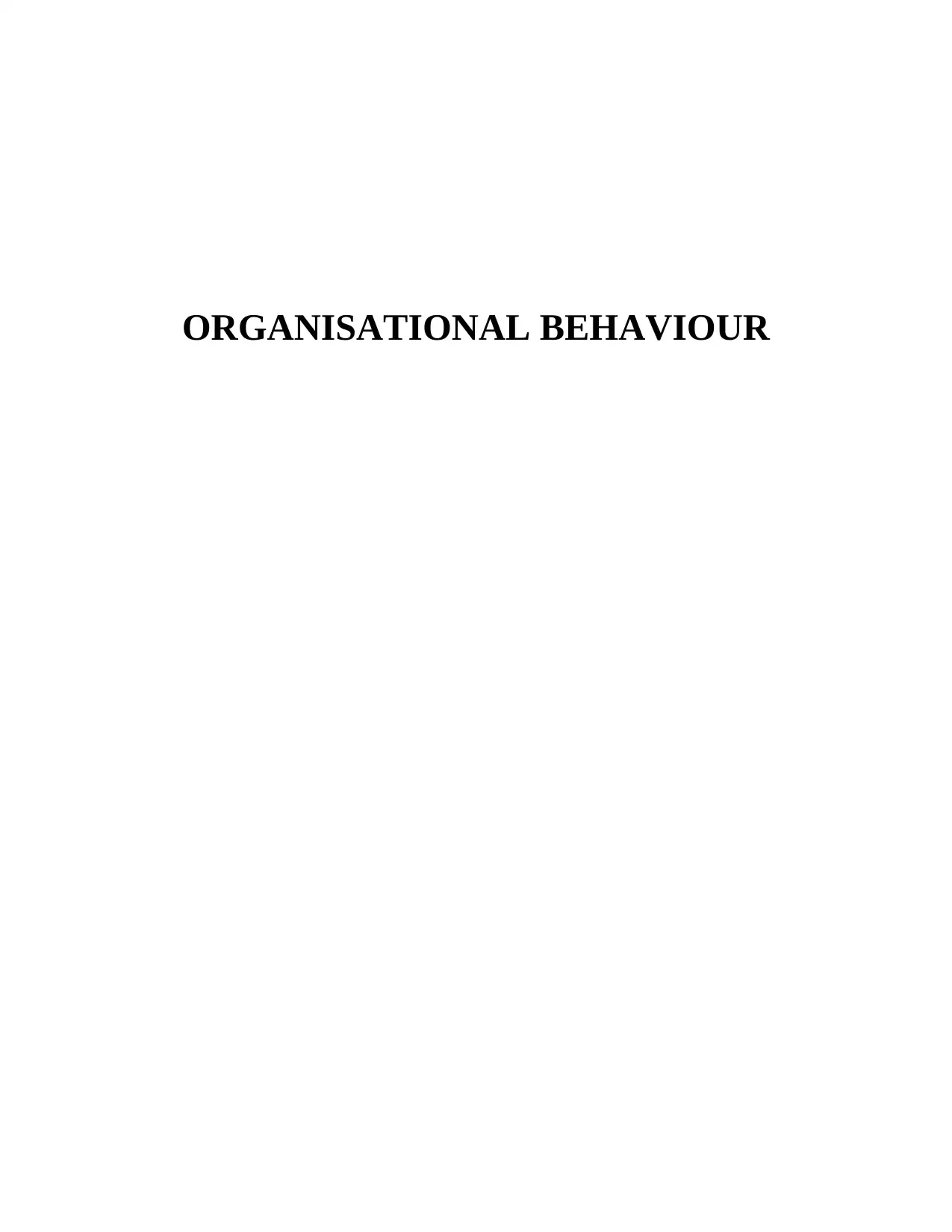
ORGANISATIONAL BEHAVIOUR
Secure Best Marks with AI Grader
Need help grading? Try our AI Grader for instant feedback on your assignments.

TABLE OF CONTENTS
INTRODUCTION...........................................................................................................................1
LO 1.................................................................................................................................................1
How an organisation’s culture, politics and power influence individual and team behaviour
and performance of A David & company....................................................................................1
LO 2.................................................................................................................................................3
Content and Process theory of motivation...................................................................................3
LO 3.................................................................................................................................................5
Differentiate between effective and ineffective team..................................................................5
LO 4.................................................................................................................................................9
Apply concepts and philosophies of organisational behaviour A David & Co Limited..........9
CONCLUSION..............................................................................................................................11
REFERENCE................................................................................................................................12
INTRODUCTION...........................................................................................................................1
LO 1.................................................................................................................................................1
How an organisation’s culture, politics and power influence individual and team behaviour
and performance of A David & company....................................................................................1
LO 2.................................................................................................................................................3
Content and Process theory of motivation...................................................................................3
LO 3.................................................................................................................................................5
Differentiate between effective and ineffective team..................................................................5
LO 4.................................................................................................................................................9
Apply concepts and philosophies of organisational behaviour A David & Co Limited..........9
CONCLUSION..............................................................................................................................11
REFERENCE................................................................................................................................12
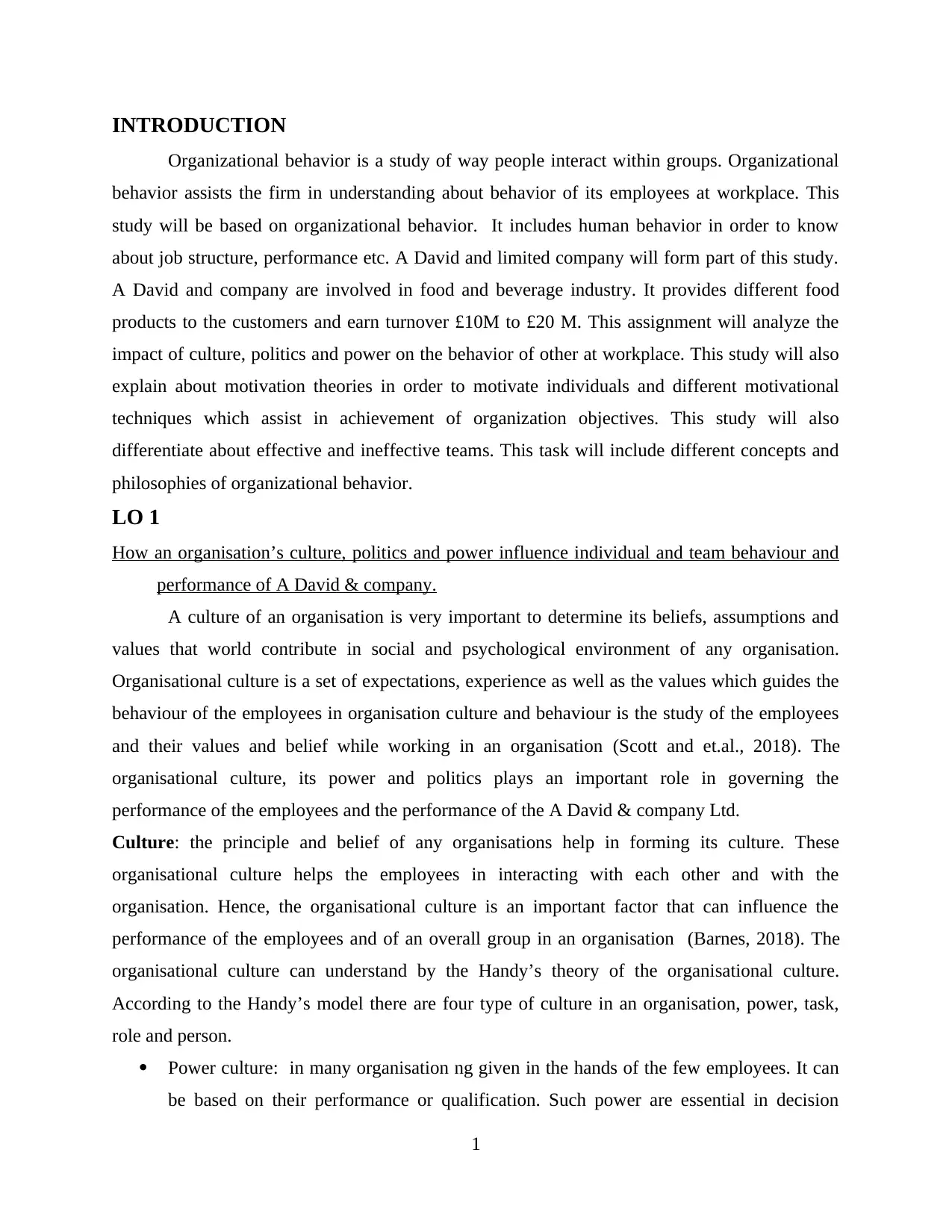
INTRODUCTION
Organizational behavior is a study of way people interact within groups. Organizational
behavior assists the firm in understanding about behavior of its employees at workplace. This
study will be based on organizational behavior. It includes human behavior in order to know
about job structure, performance etc. A David and limited company will form part of this study.
A David and company are involved in food and beverage industry. It provides different food
products to the customers and earn turnover £10M to £20 M. This assignment will analyze the
impact of culture, politics and power on the behavior of other at workplace. This study will also
explain about motivation theories in order to motivate individuals and different motivational
techniques which assist in achievement of organization objectives. This study will also
differentiate about effective and ineffective teams. This task will include different concepts and
philosophies of organizational behavior.
LO 1
How an organisation’s culture, politics and power influence individual and team behaviour and
performance of A David & company.
A culture of an organisation is very important to determine its beliefs, assumptions and
values that world contribute in social and psychological environment of any organisation.
Organisational culture is a set of expectations, experience as well as the values which guides the
behaviour of the employees in organisation culture and behaviour is the study of the employees
and their values and belief while working in an organisation (Scott and et.al., 2018). The
organisational culture, its power and politics plays an important role in governing the
performance of the employees and the performance of the A David & company Ltd.
Culture: the principle and belief of any organisations help in forming its culture. These
organisational culture helps the employees in interacting with each other and with the
organisation. Hence, the organisational culture is an important factor that can influence the
performance of the employees and of an overall group in an organisation (Barnes, 2018). The
organisational culture can understand by the Handy’s theory of the organisational culture.
According to the Handy’s model there are four type of culture in an organisation, power, task,
role and person.
Power culture: in many organisation ng given in the hands of the few employees. It can
be based on their performance or qualification. Such power are essential in decision
1
Organizational behavior is a study of way people interact within groups. Organizational
behavior assists the firm in understanding about behavior of its employees at workplace. This
study will be based on organizational behavior. It includes human behavior in order to know
about job structure, performance etc. A David and limited company will form part of this study.
A David and company are involved in food and beverage industry. It provides different food
products to the customers and earn turnover £10M to £20 M. This assignment will analyze the
impact of culture, politics and power on the behavior of other at workplace. This study will also
explain about motivation theories in order to motivate individuals and different motivational
techniques which assist in achievement of organization objectives. This study will also
differentiate about effective and ineffective teams. This task will include different concepts and
philosophies of organizational behavior.
LO 1
How an organisation’s culture, politics and power influence individual and team behaviour and
performance of A David & company.
A culture of an organisation is very important to determine its beliefs, assumptions and
values that world contribute in social and psychological environment of any organisation.
Organisational culture is a set of expectations, experience as well as the values which guides the
behaviour of the employees in organisation culture and behaviour is the study of the employees
and their values and belief while working in an organisation (Scott and et.al., 2018). The
organisational culture, its power and politics plays an important role in governing the
performance of the employees and the performance of the A David & company Ltd.
Culture: the principle and belief of any organisations help in forming its culture. These
organisational culture helps the employees in interacting with each other and with the
organisation. Hence, the organisational culture is an important factor that can influence the
performance of the employees and of an overall group in an organisation (Barnes, 2018). The
organisational culture can understand by the Handy’s theory of the organisational culture.
According to the Handy’s model there are four type of culture in an organisation, power, task,
role and person.
Power culture: in many organisation ng given in the hands of the few employees. It can
be based on their performance or qualification. Such power are essential in decision
1
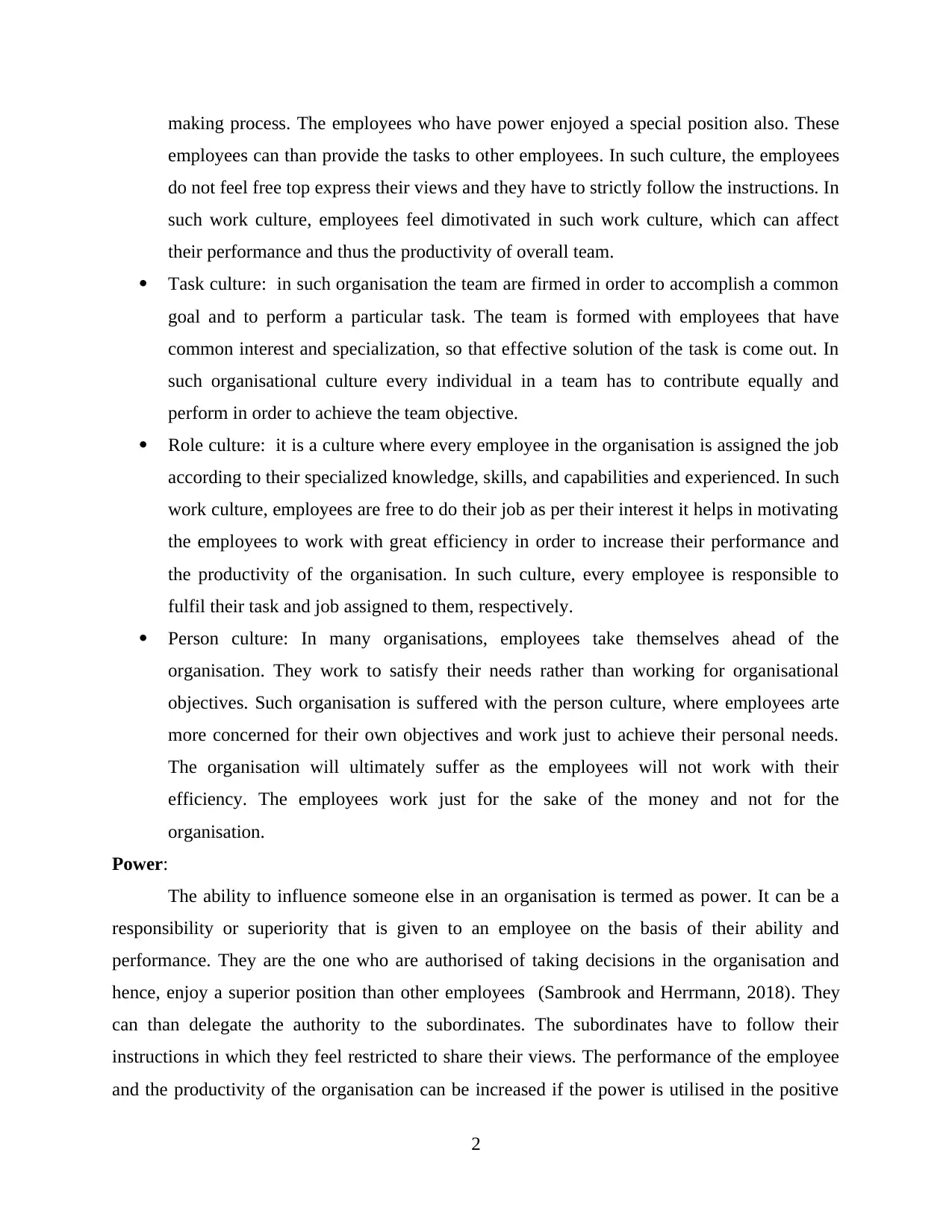
making process. The employees who have power enjoyed a special position also. These
employees can than provide the tasks to other employees. In such culture, the employees
do not feel free top express their views and they have to strictly follow the instructions. In
such work culture, employees feel dimotivated in such work culture, which can affect
their performance and thus the productivity of overall team.
Task culture: in such organisation the team are firmed in order to accomplish a common
goal and to perform a particular task. The team is formed with employees that have
common interest and specialization, so that effective solution of the task is come out. In
such organisational culture every individual in a team has to contribute equally and
perform in order to achieve the team objective.
Role culture: it is a culture where every employee in the organisation is assigned the job
according to their specialized knowledge, skills, and capabilities and experienced. In such
work culture, employees are free to do their job as per their interest it helps in motivating
the employees to work with great efficiency in order to increase their performance and
the productivity of the organisation. In such culture, every employee is responsible to
fulfil their task and job assigned to them, respectively.
Person culture: In many organisations, employees take themselves ahead of the
organisation. They work to satisfy their needs rather than working for organisational
objectives. Such organisation is suffered with the person culture, where employees arte
more concerned for their own objectives and work just to achieve their personal needs.
The organisation will ultimately suffer as the employees will not work with their
efficiency. The employees work just for the sake of the money and not for the
organisation.
Power:
The ability to influence someone else in an organisation is termed as power. It can be a
responsibility or superiority that is given to an employee on the basis of their ability and
performance. They are the one who are authorised of taking decisions in the organisation and
hence, enjoy a superior position than other employees (Sambrook and Herrmann, 2018). They
can than delegate the authority to the subordinates. The subordinates have to follow their
instructions in which they feel restricted to share their views. The performance of the employee
and the productivity of the organisation can be increased if the power is utilised in the positive
2
employees can than provide the tasks to other employees. In such culture, the employees
do not feel free top express their views and they have to strictly follow the instructions. In
such work culture, employees feel dimotivated in such work culture, which can affect
their performance and thus the productivity of overall team.
Task culture: in such organisation the team are firmed in order to accomplish a common
goal and to perform a particular task. The team is formed with employees that have
common interest and specialization, so that effective solution of the task is come out. In
such organisational culture every individual in a team has to contribute equally and
perform in order to achieve the team objective.
Role culture: it is a culture where every employee in the organisation is assigned the job
according to their specialized knowledge, skills, and capabilities and experienced. In such
work culture, employees are free to do their job as per their interest it helps in motivating
the employees to work with great efficiency in order to increase their performance and
the productivity of the organisation. In such culture, every employee is responsible to
fulfil their task and job assigned to them, respectively.
Person culture: In many organisations, employees take themselves ahead of the
organisation. They work to satisfy their needs rather than working for organisational
objectives. Such organisation is suffered with the person culture, where employees arte
more concerned for their own objectives and work just to achieve their personal needs.
The organisation will ultimately suffer as the employees will not work with their
efficiency. The employees work just for the sake of the money and not for the
organisation.
Power:
The ability to influence someone else in an organisation is termed as power. It can be a
responsibility or superiority that is given to an employee on the basis of their ability and
performance. They are the one who are authorised of taking decisions in the organisation and
hence, enjoy a superior position than other employees (Sambrook and Herrmann, 2018). They
can than delegate the authority to the subordinates. The subordinates have to follow their
instructions in which they feel restricted to share their views. The performance of the employee
and the productivity of the organisation can be increased if the power is utilised in the positive
2
Secure Best Marks with AI Grader
Need help grading? Try our AI Grader for instant feedback on your assignments.

manner. It can be done by rewarding employees for their strong performance. It can also results
in gaining power with their effective communication skills. Positive power plays a great role in
influencing the working environment of the organisation.
Whereas, the power which an employee using in an negative manner can affect the
performance of the employees in the organisation (Antonsen, 2017). The employees who do not
treat their subordinates fairly, using inappropriate forcing manner to get the work done by them
is comes under misusing of the power. Being biased to the favourites employees are comes under
using the power negatively. These will not only affect the efficiency and performance of the
employees but also decrease the quality of the overall organisation will declined.
Politics:
It is an use of the power and social networking in an organisation to achieve certain
benefits in an organisation. Politics in an organisation also very effective as employees who are
involved in such politics can be more productive than other employees. There must be an
political culture in an organisation to encourage the productivity in an organisational process.
Establishing clear rules and objectives can be easily communicated to the employees at different
level with the help of political culture. It helped in reducing the conflict environment that can
affect the productivity of the organisation, whereas, the negative politics in organisation can
create a negative environment which can affect the working of the employees and can hinder
their performance (Shapely, 2017). There can be the conflict environment where employees are
engage in unethical and dishonest or unethical behaviour to get a position in a organisation.
LO 2
Content and Process theory of motivation
The motivation is an essential factors that being used by the organisation to increase the
performance of its employees. There many theories and techniques that are been evolved in
context of motivating the employees in an organisation the content and process theories that can
be adopted by the A David & company ltd. Are:
The content theory of motivation focuses on the factors that can motivate the employees
of organisation. It is concerned with the needs of the employees and their wants. Following are
the content theories of motivation.
Herzberg’s motivation-hygiene theory:
3
in gaining power with their effective communication skills. Positive power plays a great role in
influencing the working environment of the organisation.
Whereas, the power which an employee using in an negative manner can affect the
performance of the employees in the organisation (Antonsen, 2017). The employees who do not
treat their subordinates fairly, using inappropriate forcing manner to get the work done by them
is comes under misusing of the power. Being biased to the favourites employees are comes under
using the power negatively. These will not only affect the efficiency and performance of the
employees but also decrease the quality of the overall organisation will declined.
Politics:
It is an use of the power and social networking in an organisation to achieve certain
benefits in an organisation. Politics in an organisation also very effective as employees who are
involved in such politics can be more productive than other employees. There must be an
political culture in an organisation to encourage the productivity in an organisational process.
Establishing clear rules and objectives can be easily communicated to the employees at different
level with the help of political culture. It helped in reducing the conflict environment that can
affect the productivity of the organisation, whereas, the negative politics in organisation can
create a negative environment which can affect the working of the employees and can hinder
their performance (Shapely, 2017). There can be the conflict environment where employees are
engage in unethical and dishonest or unethical behaviour to get a position in a organisation.
LO 2
Content and Process theory of motivation
The motivation is an essential factors that being used by the organisation to increase the
performance of its employees. There many theories and techniques that are been evolved in
context of motivating the employees in an organisation the content and process theories that can
be adopted by the A David & company ltd. Are:
The content theory of motivation focuses on the factors that can motivate the employees
of organisation. It is concerned with the needs of the employees and their wants. Following are
the content theories of motivation.
Herzberg’s motivation-hygiene theory:
3

This theory studies the variables which are responsible to establish a level of satisfaction
in the company. This theory focuses on what satisfied and what dissatisfied the employees in an
organisation (Hatch, 2018). According to this theory, there are two factors which affect the
behaviour of the employees in an organisation. The two factors in Herzberg motivational theory
are:
Hygiene factors: this is the first factors which referred to the maintenance or the
hygiene factor in the organisation. These factors are not considered as motivational factors but if
this is not applies in the organisation, it can leads to dissatisfaction to employees related to their
job. The hygiene factors that are not an intrinsic part of a job, but they are related to the
condition in which the employees has to performed the job (Ma, 2018). These are the company’s
administration, job security, working condition, salary, personal life etc.
Motivational factors: these factors play an important role in motivating the employees
and provide high satisfaction in the job. These have the positive effect on the employees in an
organisation. There are six factors that helps in motivating the employees, achievement, self-
esteem, recognisation, advancement, work-itself, growth and responsibilities. An increase in
these factors wiull helps in increasing the motivation of the employees. But in case they are
absent it will not dissatisfied the employees in the job.
All the process theories of motivation will be based on addressing on issues which are
related with how the process are working and sustaining itself over time like those factors which
will be determining degree of the efforts and the continuation of efforts. So all the theories under
this section will be different from content theories which are stated above as they concentrating
on what are the factors of motivation for people (The Process Theories of Motivation, 2018).
There are normally 3 types of theoires of motivation based on process which will define as to
what are the issues relating to motivation and how the procedure will be working as well.
Equity theory- Under this theory all employees with their constantly increasing with level
of efforts related to working which is againts their fellow workers. With this they will be getting
their rewards for efforts which is termed to as their good and better increase of performance. If
the employees are finding any kind of difference begtween their level of efforts and working of
fellow workers. At this time they will be adjusting their own performance either down or up with
taking certain type of measures so that their level of performance could be improved. If they are
comparing their efforts with performanc of other employees and finding that there is no such
4
in the company. This theory focuses on what satisfied and what dissatisfied the employees in an
organisation (Hatch, 2018). According to this theory, there are two factors which affect the
behaviour of the employees in an organisation. The two factors in Herzberg motivational theory
are:
Hygiene factors: this is the first factors which referred to the maintenance or the
hygiene factor in the organisation. These factors are not considered as motivational factors but if
this is not applies in the organisation, it can leads to dissatisfaction to employees related to their
job. The hygiene factors that are not an intrinsic part of a job, but they are related to the
condition in which the employees has to performed the job (Ma, 2018). These are the company’s
administration, job security, working condition, salary, personal life etc.
Motivational factors: these factors play an important role in motivating the employees
and provide high satisfaction in the job. These have the positive effect on the employees in an
organisation. There are six factors that helps in motivating the employees, achievement, self-
esteem, recognisation, advancement, work-itself, growth and responsibilities. An increase in
these factors wiull helps in increasing the motivation of the employees. But in case they are
absent it will not dissatisfied the employees in the job.
All the process theories of motivation will be based on addressing on issues which are
related with how the process are working and sustaining itself over time like those factors which
will be determining degree of the efforts and the continuation of efforts. So all the theories under
this section will be different from content theories which are stated above as they concentrating
on what are the factors of motivation for people (The Process Theories of Motivation, 2018).
There are normally 3 types of theoires of motivation based on process which will define as to
what are the issues relating to motivation and how the procedure will be working as well.
Equity theory- Under this theory all employees with their constantly increasing with level
of efforts related to working which is againts their fellow workers. With this they will be getting
their rewards for efforts which is termed to as their good and better increase of performance. If
the employees are finding any kind of difference begtween their level of efforts and working of
fellow workers. At this time they will be adjusting their own performance either down or up with
taking certain type of measures so that their level of performance could be improved. If they are
comparing their efforts with performanc of other employees and finding that there is no such
4

difference between both of them then this will be called to as equity as this is the situation to
maintain motivation.
Expectancy theory- This theory is concerned with motivation being the decision making
process that will evaluate efforts for the outcome. The expectancy theory will be highlighting
contributing with choice of user within process and active cognitive process with including
importnace of outcome that is valued for rewarding individual.
Porter- Lawler Model- As per this model theory of motivation is mainly based on
expectancy theory that is on workplace motivation (De Vito, Cianci and Mujtaba, 2018). All the
theories of motiavtion will be included within this model with having elements of all other
process and content theories of motivation. Although this model is very much complex that of
individual theories that includes that reward provided to individual will be having practical
limiation.
All these theories of motivation whether it is process and content one will be having
effective achievemnet of goals within A David & Co Limited which is food and beverages
company. With the help of motivationall theories employer will be able to motivate its
employees so that they could be performing as per the target set to achieve goal of A David &
Co Limited.
LO 3
Differentiate between effective and ineffective team
Effective team consists of individual and group working together to achieve the common
goal of organization. It involves individuals and groups to effectively achieve the objectives.
Ineffective team consists of those individual and group which are not productive for organization
and are inefficient towards achieving the organizational objectives (Gunes, Solak and Sariel,
2016). The following table will be based on difference between effective and ineffective team.
Basis of difference Effective team Ineffective team
Definition Effective team is that which
work in a group to achieve the
common objectives of the
organization. Effective team
assists the organization in
increasing their productivity
Ineffective team refers to that
group which does not work
together and thus they are not
able to achieve the group
goals. Ineffective team does
not have clear goals and thus
5
maintain motivation.
Expectancy theory- This theory is concerned with motivation being the decision making
process that will evaluate efforts for the outcome. The expectancy theory will be highlighting
contributing with choice of user within process and active cognitive process with including
importnace of outcome that is valued for rewarding individual.
Porter- Lawler Model- As per this model theory of motivation is mainly based on
expectancy theory that is on workplace motivation (De Vito, Cianci and Mujtaba, 2018). All the
theories of motiavtion will be included within this model with having elements of all other
process and content theories of motivation. Although this model is very much complex that of
individual theories that includes that reward provided to individual will be having practical
limiation.
All these theories of motivation whether it is process and content one will be having
effective achievemnet of goals within A David & Co Limited which is food and beverages
company. With the help of motivationall theories employer will be able to motivate its
employees so that they could be performing as per the target set to achieve goal of A David &
Co Limited.
LO 3
Differentiate between effective and ineffective team
Effective team consists of individual and group working together to achieve the common
goal of organization. It involves individuals and groups to effectively achieve the objectives.
Ineffective team consists of those individual and group which are not productive for organization
and are inefficient towards achieving the organizational objectives (Gunes, Solak and Sariel,
2016). The following table will be based on difference between effective and ineffective team.
Basis of difference Effective team Ineffective team
Definition Effective team is that which
work in a group to achieve the
common objectives of the
organization. Effective team
assists the organization in
increasing their productivity
Ineffective team refers to that
group which does not work
together and thus they are not
able to achieve the group
goals. Ineffective team does
not have clear goals and thus
5
Paraphrase This Document
Need a fresh take? Get an instant paraphrase of this document with our AI Paraphraser
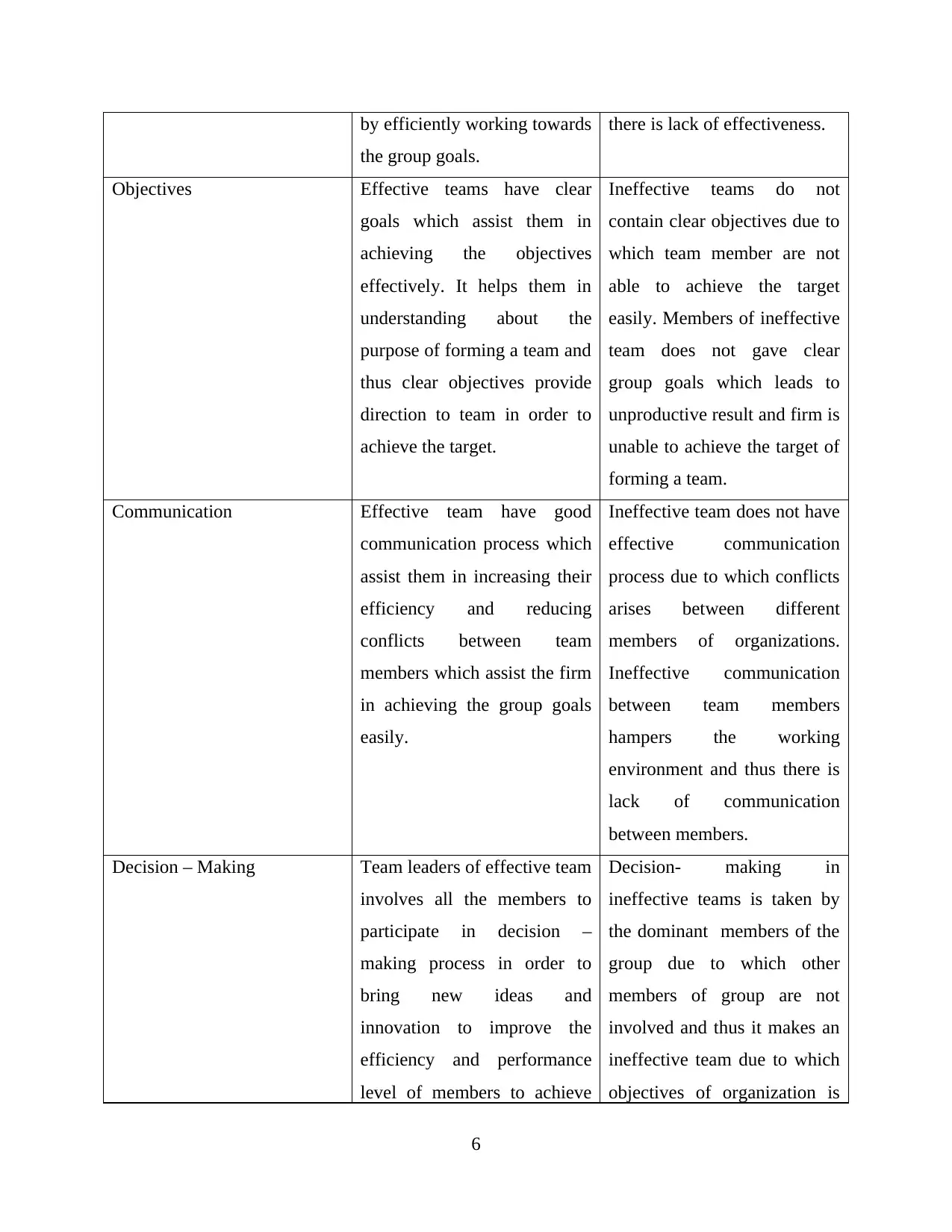
by efficiently working towards
the group goals.
there is lack of effectiveness.
Objectives Effective teams have clear
goals which assist them in
achieving the objectives
effectively. It helps them in
understanding about the
purpose of forming a team and
thus clear objectives provide
direction to team in order to
achieve the target.
Ineffective teams do not
contain clear objectives due to
which team member are not
able to achieve the target
easily. Members of ineffective
team does not gave clear
group goals which leads to
unproductive result and firm is
unable to achieve the target of
forming a team.
Communication Effective team have good
communication process which
assist them in increasing their
efficiency and reducing
conflicts between team
members which assist the firm
in achieving the group goals
easily.
Ineffective team does not have
effective communication
process due to which conflicts
arises between different
members of organizations.
Ineffective communication
between team members
hampers the working
environment and thus there is
lack of communication
between members.
Decision – Making Team leaders of effective team
involves all the members to
participate in decision –
making process in order to
bring new ideas and
innovation to improve the
efficiency and performance
level of members to achieve
Decision- making in
ineffective teams is taken by
the dominant members of the
group due to which other
members of group are not
involved and thus it makes an
ineffective team due to which
objectives of organization is
6
the group goals.
there is lack of effectiveness.
Objectives Effective teams have clear
goals which assist them in
achieving the objectives
effectively. It helps them in
understanding about the
purpose of forming a team and
thus clear objectives provide
direction to team in order to
achieve the target.
Ineffective teams do not
contain clear objectives due to
which team member are not
able to achieve the target
easily. Members of ineffective
team does not gave clear
group goals which leads to
unproductive result and firm is
unable to achieve the target of
forming a team.
Communication Effective team have good
communication process which
assist them in increasing their
efficiency and reducing
conflicts between team
members which assist the firm
in achieving the group goals
easily.
Ineffective team does not have
effective communication
process due to which conflicts
arises between different
members of organizations.
Ineffective communication
between team members
hampers the working
environment and thus there is
lack of communication
between members.
Decision – Making Team leaders of effective team
involves all the members to
participate in decision –
making process in order to
bring new ideas and
innovation to improve the
efficiency and performance
level of members to achieve
Decision- making in
ineffective teams is taken by
the dominant members of the
group due to which other
members of group are not
involved and thus it makes an
ineffective team due to which
objectives of organization is
6

the objectives effectively.
Decision is made with the
agreement of every member of
group (Willems, 2016).
not achieved.
Motivation Team leader of effective team
provide motivation to its
members in order to
encourage them to increase
their performance level in
order achieve individual and
group goals.
Leaders of ineffective give the
members negative motivation
due to which employees are
demotivated and punished for
working properly.
Trust and commitment Effective team members have
faith on each members of the
group and are committed
towards the work in order to
achieve the targeted goals of
organization.
Members of Ineffective team
does not have trust on the
other member of group due to
which work in not properly
managed and thus it leads to
ineffective results.
leadership Effective team leader provide
right direction to its team
member in order achieve the
objectives of group. Team
leader have strong leadership
qualities which helps them in
making right decision and
provide clear objectives to
achieve the objectives of firm.
Leader of ineffective does not
have clear knowledge and
skills which hampers the
working of team as team
leader is not able to provide
direction to team to achieve
the objectives of enterprise.
There are different group development theories which lead to dynamic cooperation. It
consists of Belbin typology theory and Tuckmen theory of group development. Belbin theory is
based on behavior of team members and have identified three roles on the basis of which
behavior of team member is identified for cooperation.
7
Decision is made with the
agreement of every member of
group (Willems, 2016).
not achieved.
Motivation Team leader of effective team
provide motivation to its
members in order to
encourage them to increase
their performance level in
order achieve individual and
group goals.
Leaders of ineffective give the
members negative motivation
due to which employees are
demotivated and punished for
working properly.
Trust and commitment Effective team members have
faith on each members of the
group and are committed
towards the work in order to
achieve the targeted goals of
organization.
Members of Ineffective team
does not have trust on the
other member of group due to
which work in not properly
managed and thus it leads to
ineffective results.
leadership Effective team leader provide
right direction to its team
member in order achieve the
objectives of group. Team
leader have strong leadership
qualities which helps them in
making right decision and
provide clear objectives to
achieve the objectives of firm.
Leader of ineffective does not
have clear knowledge and
skills which hampers the
working of team as team
leader is not able to provide
direction to team to achieve
the objectives of enterprise.
There are different group development theories which lead to dynamic cooperation. It
consists of Belbin typology theory and Tuckmen theory of group development. Belbin theory is
based on behavior of team members and have identified three roles on the basis of which
behavior of team member is identified for cooperation.
7
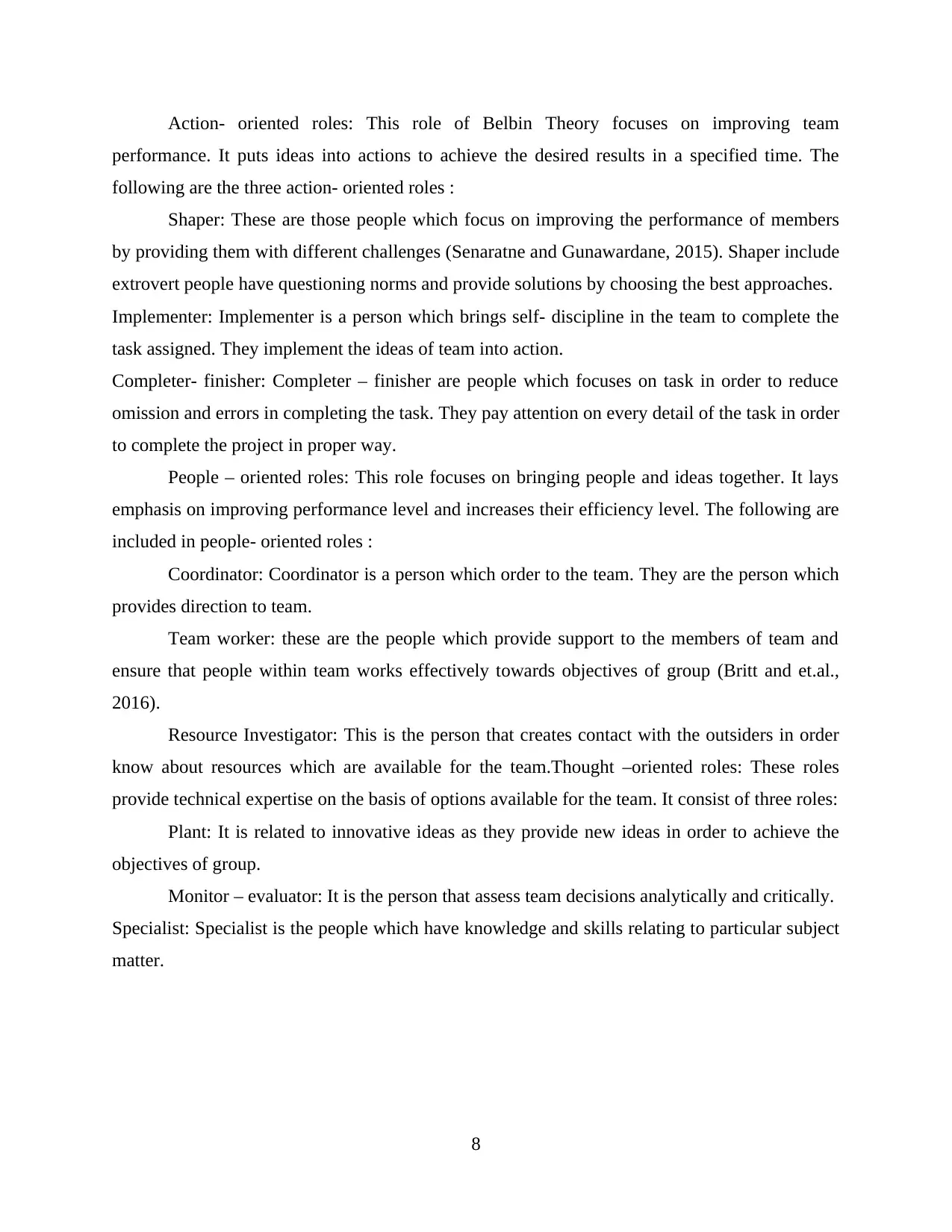
Action- oriented roles: This role of Belbin Theory focuses on improving team
performance. It puts ideas into actions to achieve the desired results in a specified time. The
following are the three action- oriented roles :
Shaper: These are those people which focus on improving the performance of members
by providing them with different challenges (Senaratne and Gunawardane, 2015). Shaper include
extrovert people have questioning norms and provide solutions by choosing the best approaches.
Implementer: Implementer is a person which brings self- discipline in the team to complete the
task assigned. They implement the ideas of team into action.
Completer- finisher: Completer – finisher are people which focuses on task in order to reduce
omission and errors in completing the task. They pay attention on every detail of the task in order
to complete the project in proper way.
People – oriented roles: This role focuses on bringing people and ideas together. It lays
emphasis on improving performance level and increases their efficiency level. The following are
included in people- oriented roles :
Coordinator: Coordinator is a person which order to the team. They are the person which
provides direction to team.
Team worker: these are the people which provide support to the members of team and
ensure that people within team works effectively towards objectives of group (Britt and et.al.,
2016).
Resource Investigator: This is the person that creates contact with the outsiders in order
know about resources which are available for the team.Thought –oriented roles: These roles
provide technical expertise on the basis of options available for the team. It consist of three roles:
Plant: It is related to innovative ideas as they provide new ideas in order to achieve the
objectives of group.
Monitor – evaluator: It is the person that assess team decisions analytically and critically.
Specialist: Specialist is the people which have knowledge and skills relating to particular subject
matter.
8
performance. It puts ideas into actions to achieve the desired results in a specified time. The
following are the three action- oriented roles :
Shaper: These are those people which focus on improving the performance of members
by providing them with different challenges (Senaratne and Gunawardane, 2015). Shaper include
extrovert people have questioning norms and provide solutions by choosing the best approaches.
Implementer: Implementer is a person which brings self- discipline in the team to complete the
task assigned. They implement the ideas of team into action.
Completer- finisher: Completer – finisher are people which focuses on task in order to reduce
omission and errors in completing the task. They pay attention on every detail of the task in order
to complete the project in proper way.
People – oriented roles: This role focuses on bringing people and ideas together. It lays
emphasis on improving performance level and increases their efficiency level. The following are
included in people- oriented roles :
Coordinator: Coordinator is a person which order to the team. They are the person which
provides direction to team.
Team worker: these are the people which provide support to the members of team and
ensure that people within team works effectively towards objectives of group (Britt and et.al.,
2016).
Resource Investigator: This is the person that creates contact with the outsiders in order
know about resources which are available for the team.Thought –oriented roles: These roles
provide technical expertise on the basis of options available for the team. It consist of three roles:
Plant: It is related to innovative ideas as they provide new ideas in order to achieve the
objectives of group.
Monitor – evaluator: It is the person that assess team decisions analytically and critically.
Specialist: Specialist is the people which have knowledge and skills relating to particular subject
matter.
8
Secure Best Marks with AI Grader
Need help grading? Try our AI Grader for instant feedback on your assignments.
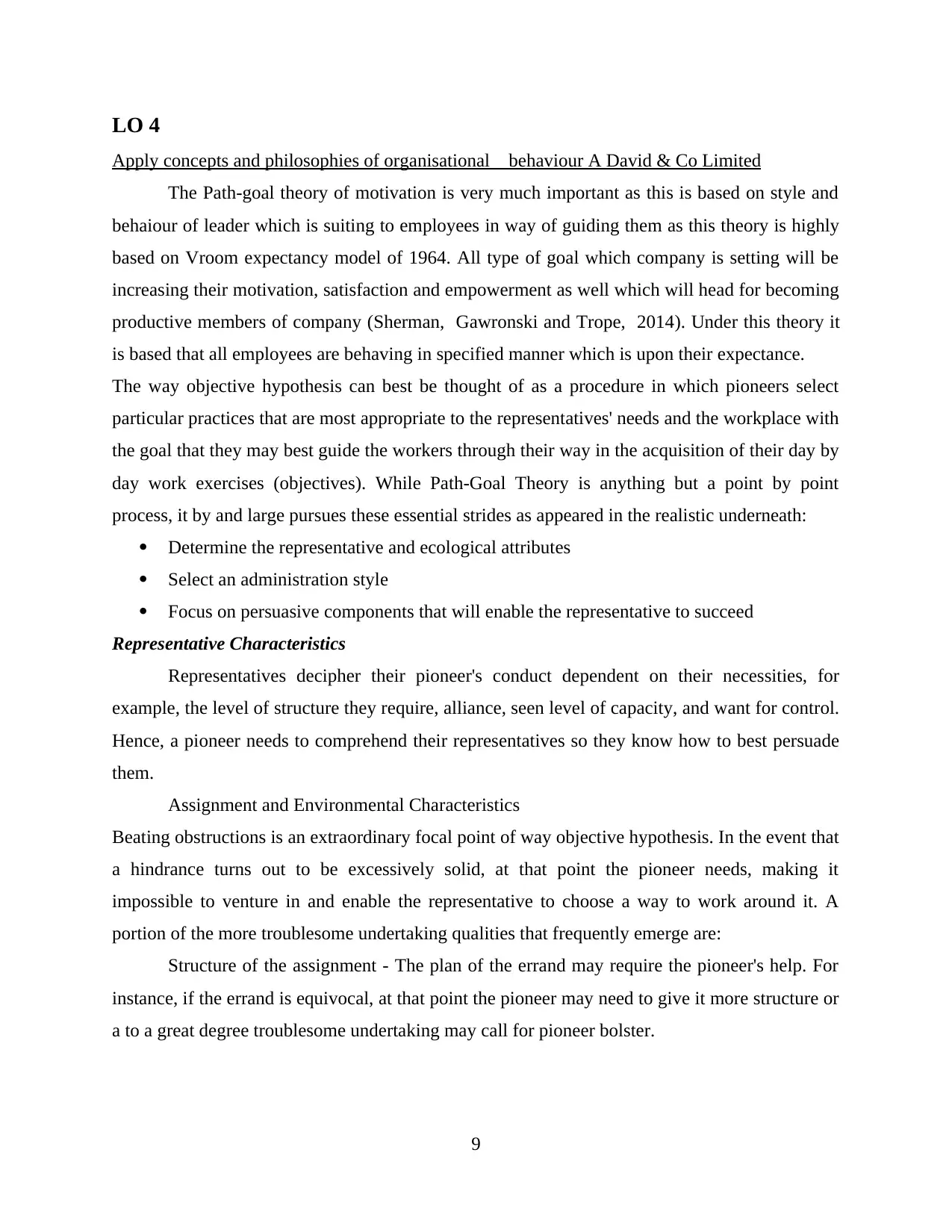
LO 4
Apply concepts and philosophies of organisational behaviour A David & Co Limited
The Path-goal theory of motivation is very much important as this is based on style and
behaiour of leader which is suiting to employees in way of guiding them as this theory is highly
based on Vroom expectancy model of 1964. All type of goal which company is setting will be
increasing their motivation, satisfaction and empowerment as well which will head for becoming
productive members of company (Sherman, Gawronski and Trope, 2014). Under this theory it
is based that all employees are behaving in specified manner which is upon their expectance.
The way objective hypothesis can best be thought of as a procedure in which pioneers select
particular practices that are most appropriate to the representatives' needs and the workplace with
the goal that they may best guide the workers through their way in the acquisition of their day by
day work exercises (objectives). While Path-Goal Theory is anything but a point by point
process, it by and large pursues these essential strides as appeared in the realistic underneath:
Determine the representative and ecological attributes
Select an administration style
Focus on persuasive components that will enable the representative to succeed
Representative Characteristics
Representatives decipher their pioneer's conduct dependent on their necessities, for
example, the level of structure they require, alliance, seen level of capacity, and want for control.
Hence, a pioneer needs to comprehend their representatives so they know how to best persuade
them.
Assignment and Environmental Characteristics
Beating obstructions is an extraordinary focal point of way objective hypothesis. In the event that
a hindrance turns out to be excessively solid, at that point the pioneer needs, making it
impossible to venture in and enable the representative to choose a way to work around it. A
portion of the more troublesome undertaking qualities that frequently emerge are:
Structure of the assignment - The plan of the errand may require the pioneer's help. For
instance, if the errand is equivocal, at that point the pioneer may need to give it more structure or
a to a great degree troublesome undertaking may call for pioneer bolster.
9
Apply concepts and philosophies of organisational behaviour A David & Co Limited
The Path-goal theory of motivation is very much important as this is based on style and
behaiour of leader which is suiting to employees in way of guiding them as this theory is highly
based on Vroom expectancy model of 1964. All type of goal which company is setting will be
increasing their motivation, satisfaction and empowerment as well which will head for becoming
productive members of company (Sherman, Gawronski and Trope, 2014). Under this theory it
is based that all employees are behaving in specified manner which is upon their expectance.
The way objective hypothesis can best be thought of as a procedure in which pioneers select
particular practices that are most appropriate to the representatives' needs and the workplace with
the goal that they may best guide the workers through their way in the acquisition of their day by
day work exercises (objectives). While Path-Goal Theory is anything but a point by point
process, it by and large pursues these essential strides as appeared in the realistic underneath:
Determine the representative and ecological attributes
Select an administration style
Focus on persuasive components that will enable the representative to succeed
Representative Characteristics
Representatives decipher their pioneer's conduct dependent on their necessities, for
example, the level of structure they require, alliance, seen level of capacity, and want for control.
Hence, a pioneer needs to comprehend their representatives so they know how to best persuade
them.
Assignment and Environmental Characteristics
Beating obstructions is an extraordinary focal point of way objective hypothesis. In the event that
a hindrance turns out to be excessively solid, at that point the pioneer needs, making it
impossible to venture in and enable the representative to choose a way to work around it. A
portion of the more troublesome undertaking qualities that frequently emerge are:
Structure of the assignment - The plan of the errand may require the pioneer's help. For
instance, if the errand is equivocal, at that point the pioneer may need to give it more structure or
a to a great degree troublesome undertaking may call for pioneer bolster.
9
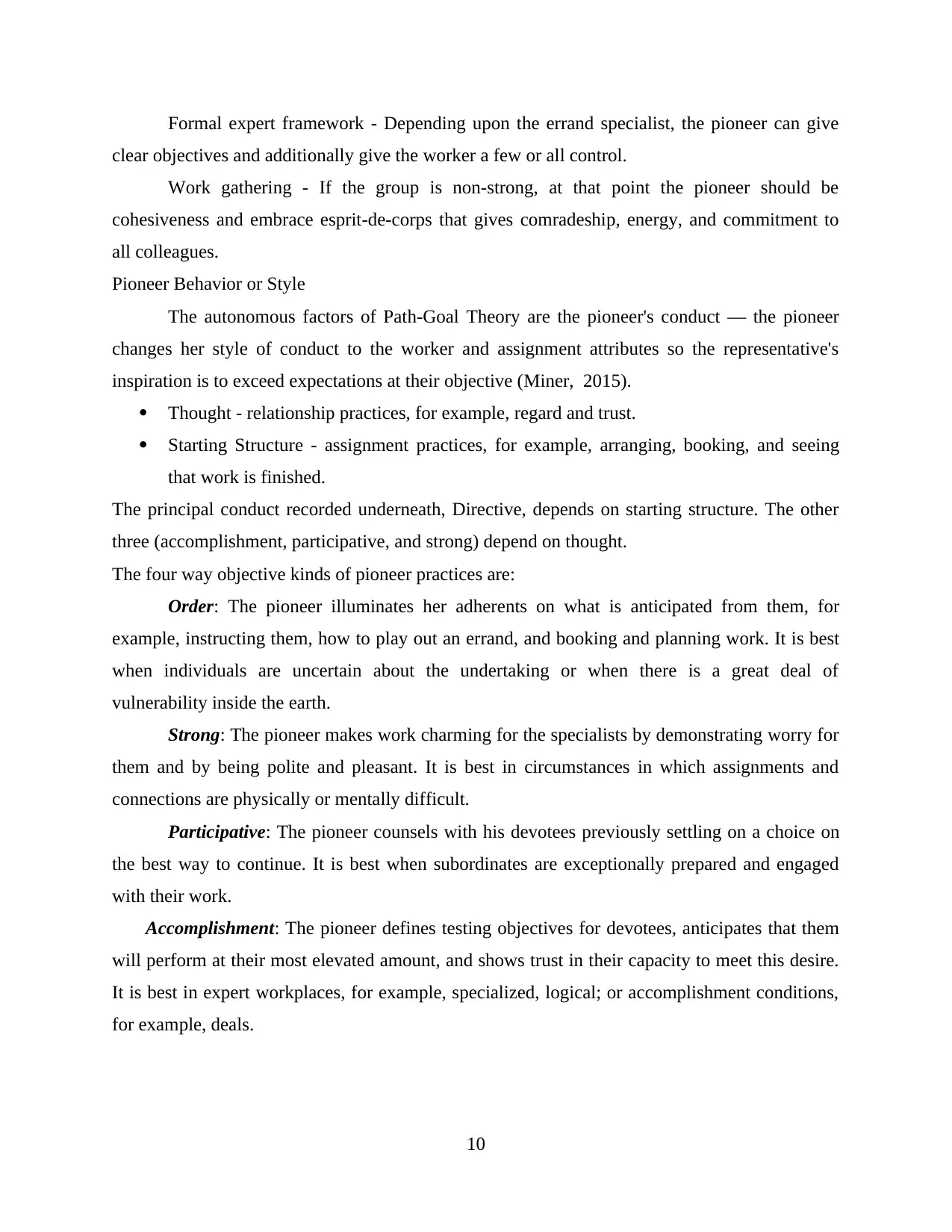
Formal expert framework - Depending upon the errand specialist, the pioneer can give
clear objectives and additionally give the worker a few or all control.
Work gathering - If the group is non-strong, at that point the pioneer should be
cohesiveness and embrace esprit-de-corps that gives comradeship, energy, and commitment to
all colleagues.
Pioneer Behavior or Style
The autonomous factors of Path-Goal Theory are the pioneer's conduct — the pioneer
changes her style of conduct to the worker and assignment attributes so the representative's
inspiration is to exceed expectations at their objective (Miner, 2015).
Thought - relationship practices, for example, regard and trust.
Starting Structure - assignment practices, for example, arranging, booking, and seeing
that work is finished.
The principal conduct recorded underneath, Directive, depends on starting structure. The other
three (accomplishment, participative, and strong) depend on thought.
The four way objective kinds of pioneer practices are:
Order: The pioneer illuminates her adherents on what is anticipated from them, for
example, instructing them, how to play out an errand, and booking and planning work. It is best
when individuals are uncertain about the undertaking or when there is a great deal of
vulnerability inside the earth.
Strong: The pioneer makes work charming for the specialists by demonstrating worry for
them and by being polite and pleasant. It is best in circumstances in which assignments and
connections are physically or mentally difficult.
Participative: The pioneer counsels with his devotees previously settling on a choice on
the best way to continue. It is best when subordinates are exceptionally prepared and engaged
with their work.
Accomplishment: The pioneer defines testing objectives for devotees, anticipates that them
will perform at their most elevated amount, and shows trust in their capacity to meet this desire.
It is best in expert workplaces, for example, specialized, logical; or accomplishment conditions,
for example, deals.
10
clear objectives and additionally give the worker a few or all control.
Work gathering - If the group is non-strong, at that point the pioneer should be
cohesiveness and embrace esprit-de-corps that gives comradeship, energy, and commitment to
all colleagues.
Pioneer Behavior or Style
The autonomous factors of Path-Goal Theory are the pioneer's conduct — the pioneer
changes her style of conduct to the worker and assignment attributes so the representative's
inspiration is to exceed expectations at their objective (Miner, 2015).
Thought - relationship practices, for example, regard and trust.
Starting Structure - assignment practices, for example, arranging, booking, and seeing
that work is finished.
The principal conduct recorded underneath, Directive, depends on starting structure. The other
three (accomplishment, participative, and strong) depend on thought.
The four way objective kinds of pioneer practices are:
Order: The pioneer illuminates her adherents on what is anticipated from them, for
example, instructing them, how to play out an errand, and booking and planning work. It is best
when individuals are uncertain about the undertaking or when there is a great deal of
vulnerability inside the earth.
Strong: The pioneer makes work charming for the specialists by demonstrating worry for
them and by being polite and pleasant. It is best in circumstances in which assignments and
connections are physically or mentally difficult.
Participative: The pioneer counsels with his devotees previously settling on a choice on
the best way to continue. It is best when subordinates are exceptionally prepared and engaged
with their work.
Accomplishment: The pioneer defines testing objectives for devotees, anticipates that them
will perform at their most elevated amount, and shows trust in their capacity to meet this desire.
It is best in expert workplaces, for example, specialized, logical; or accomplishment conditions,
for example, deals.
10
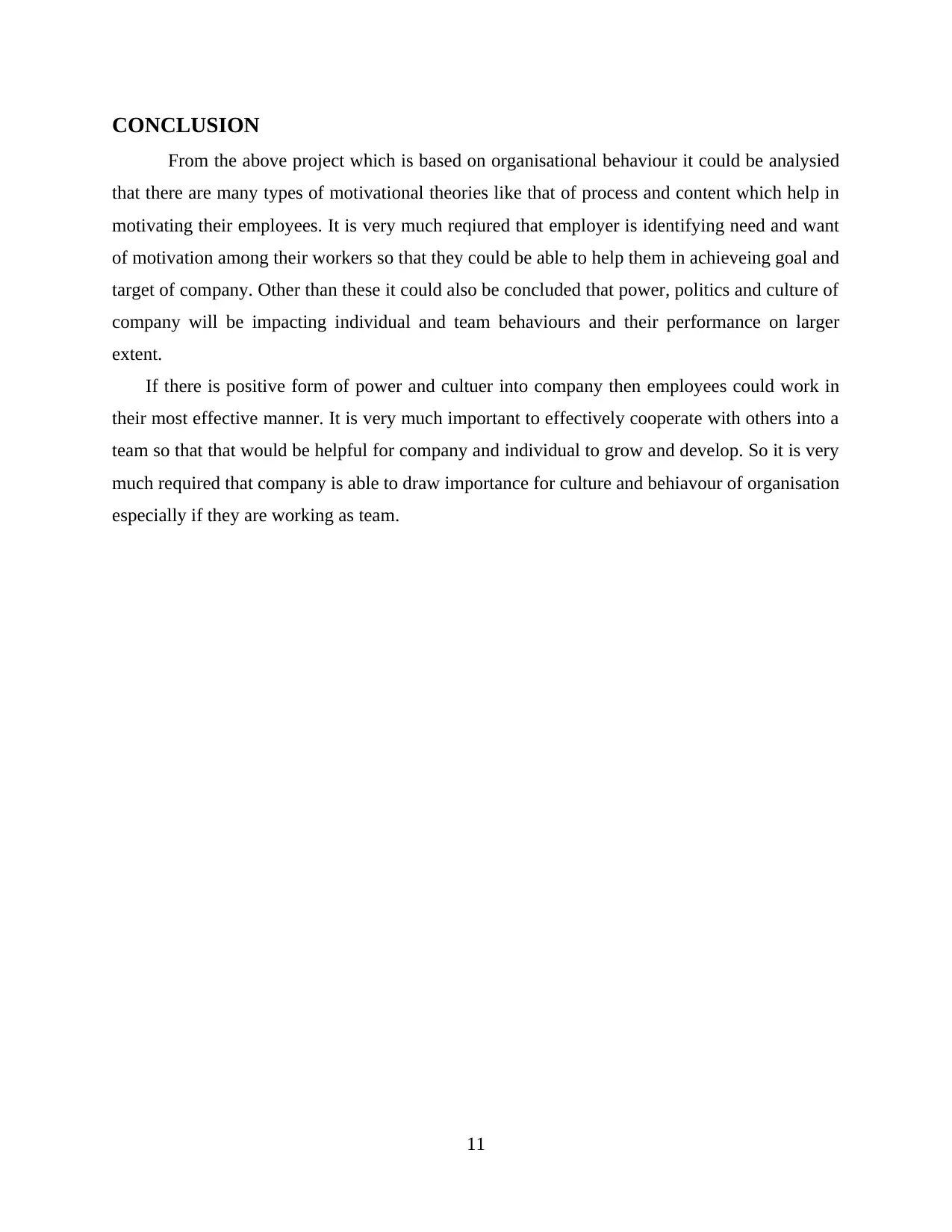
CONCLUSION
From the above project which is based on organisational behaviour it could be analysied
that there are many types of motivational theories like that of process and content which help in
motivating their employees. It is very much reqiured that employer is identifying need and want
of motivation among their workers so that they could be able to help them in achieveing goal and
target of company. Other than these it could also be concluded that power, politics and culture of
company will be impacting individual and team behaviours and their performance on larger
extent.
If there is positive form of power and cultuer into company then employees could work in
their most effective manner. It is very much important to effectively cooperate with others into a
team so that that would be helpful for company and individual to grow and develop. So it is very
much required that company is able to draw importance for culture and behiavour of organisation
especially if they are working as team.
11
From the above project which is based on organisational behaviour it could be analysied
that there are many types of motivational theories like that of process and content which help in
motivating their employees. It is very much reqiured that employer is identifying need and want
of motivation among their workers so that they could be able to help them in achieveing goal and
target of company. Other than these it could also be concluded that power, politics and culture of
company will be impacting individual and team behaviours and their performance on larger
extent.
If there is positive form of power and cultuer into company then employees could work in
their most effective manner. It is very much important to effectively cooperate with others into a
team so that that would be helpful for company and individual to grow and develop. So it is very
much required that company is able to draw importance for culture and behiavour of organisation
especially if they are working as team.
11
Paraphrase This Document
Need a fresh take? Get an instant paraphrase of this document with our AI Paraphraser
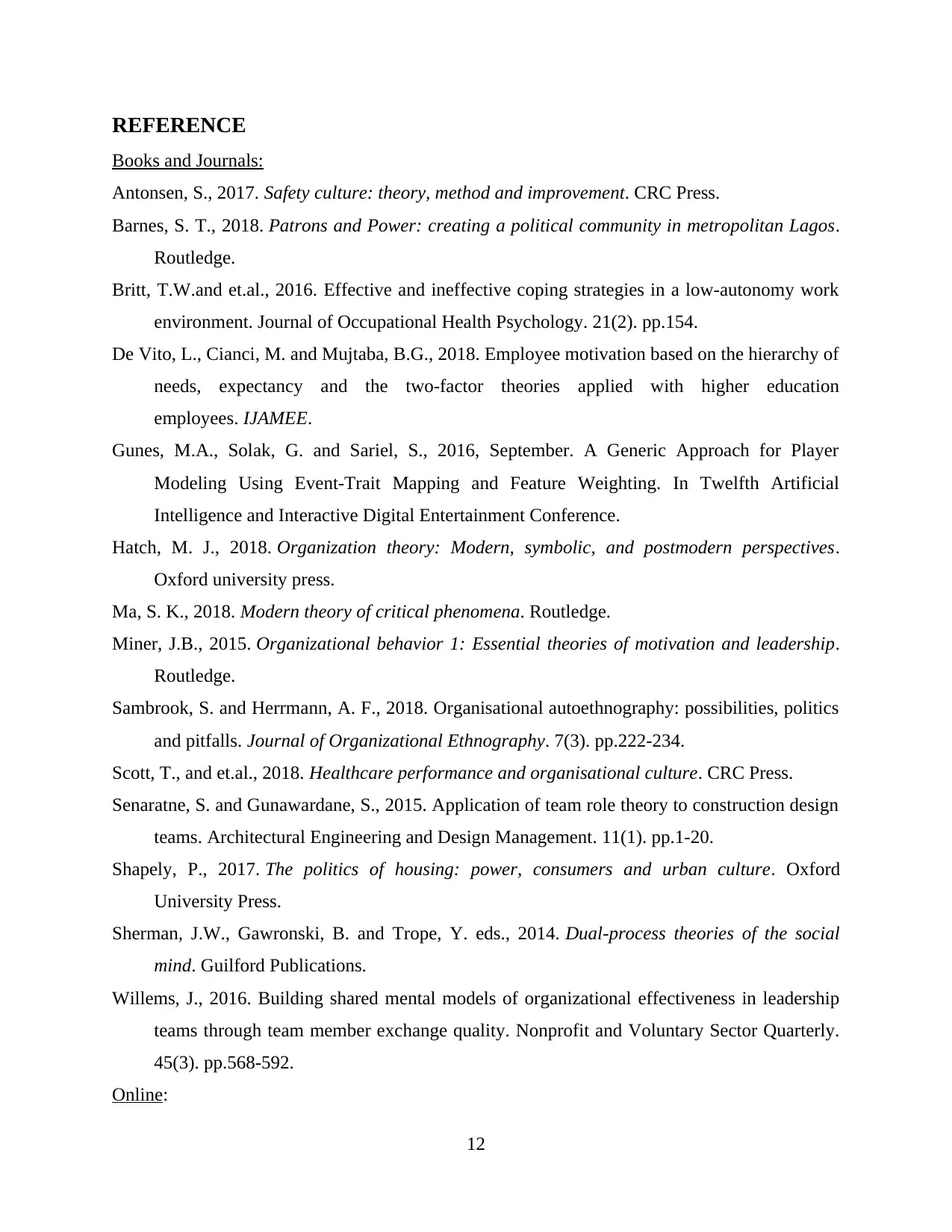
REFERENCE
Books and Journals:
Antonsen, S., 2017. Safety culture: theory, method and improvement. CRC Press.
Barnes, S. T., 2018. Patrons and Power: creating a political community in metropolitan Lagos.
Routledge.
Britt, T.W.and et.al., 2016. Effective and ineffective coping strategies in a low-autonomy work
environment. Journal of Occupational Health Psychology. 21(2). pp.154.
De Vito, L., Cianci, M. and Mujtaba, B.G., 2018. Employee motivation based on the hierarchy of
needs, expectancy and the two-factor theories applied with higher education
employees. IJAMEE.
Gunes, M.A., Solak, G. and Sariel, S., 2016, September. A Generic Approach for Player
Modeling Using Event-Trait Mapping and Feature Weighting. In Twelfth Artificial
Intelligence and Interactive Digital Entertainment Conference.
Hatch, M. J., 2018. Organization theory: Modern, symbolic, and postmodern perspectives.
Oxford university press.
Ma, S. K., 2018. Modern theory of critical phenomena. Routledge.
Miner, J.B., 2015. Organizational behavior 1: Essential theories of motivation and leadership.
Routledge.
Sambrook, S. and Herrmann, A. F., 2018. Organisational autoethnography: possibilities, politics
and pitfalls. Journal of Organizational Ethnography. 7(3). pp.222-234.
Scott, T., and et.al., 2018. Healthcare performance and organisational culture. CRC Press.
Senaratne, S. and Gunawardane, S., 2015. Application of team role theory to construction design
teams. Architectural Engineering and Design Management. 11(1). pp.1-20.
Shapely, P., 2017. The politics of housing: power, consumers and urban culture. Oxford
University Press.
Sherman, J.W., Gawronski, B. and Trope, Y. eds., 2014. Dual-process theories of the social
mind. Guilford Publications.
Willems, J., 2016. Building shared mental models of organizational effectiveness in leadership
teams through team member exchange quality. Nonprofit and Voluntary Sector Quarterly.
45(3). pp.568-592.
Online:
12
Books and Journals:
Antonsen, S., 2017. Safety culture: theory, method and improvement. CRC Press.
Barnes, S. T., 2018. Patrons and Power: creating a political community in metropolitan Lagos.
Routledge.
Britt, T.W.and et.al., 2016. Effective and ineffective coping strategies in a low-autonomy work
environment. Journal of Occupational Health Psychology. 21(2). pp.154.
De Vito, L., Cianci, M. and Mujtaba, B.G., 2018. Employee motivation based on the hierarchy of
needs, expectancy and the two-factor theories applied with higher education
employees. IJAMEE.
Gunes, M.A., Solak, G. and Sariel, S., 2016, September. A Generic Approach for Player
Modeling Using Event-Trait Mapping and Feature Weighting. In Twelfth Artificial
Intelligence and Interactive Digital Entertainment Conference.
Hatch, M. J., 2018. Organization theory: Modern, symbolic, and postmodern perspectives.
Oxford university press.
Ma, S. K., 2018. Modern theory of critical phenomena. Routledge.
Miner, J.B., 2015. Organizational behavior 1: Essential theories of motivation and leadership.
Routledge.
Sambrook, S. and Herrmann, A. F., 2018. Organisational autoethnography: possibilities, politics
and pitfalls. Journal of Organizational Ethnography. 7(3). pp.222-234.
Scott, T., and et.al., 2018. Healthcare performance and organisational culture. CRC Press.
Senaratne, S. and Gunawardane, S., 2015. Application of team role theory to construction design
teams. Architectural Engineering and Design Management. 11(1). pp.1-20.
Shapely, P., 2017. The politics of housing: power, consumers and urban culture. Oxford
University Press.
Sherman, J.W., Gawronski, B. and Trope, Y. eds., 2014. Dual-process theories of the social
mind. Guilford Publications.
Willems, J., 2016. Building shared mental models of organizational effectiveness in leadership
teams through team member exchange quality. Nonprofit and Voluntary Sector Quarterly.
45(3). pp.568-592.
Online:
12
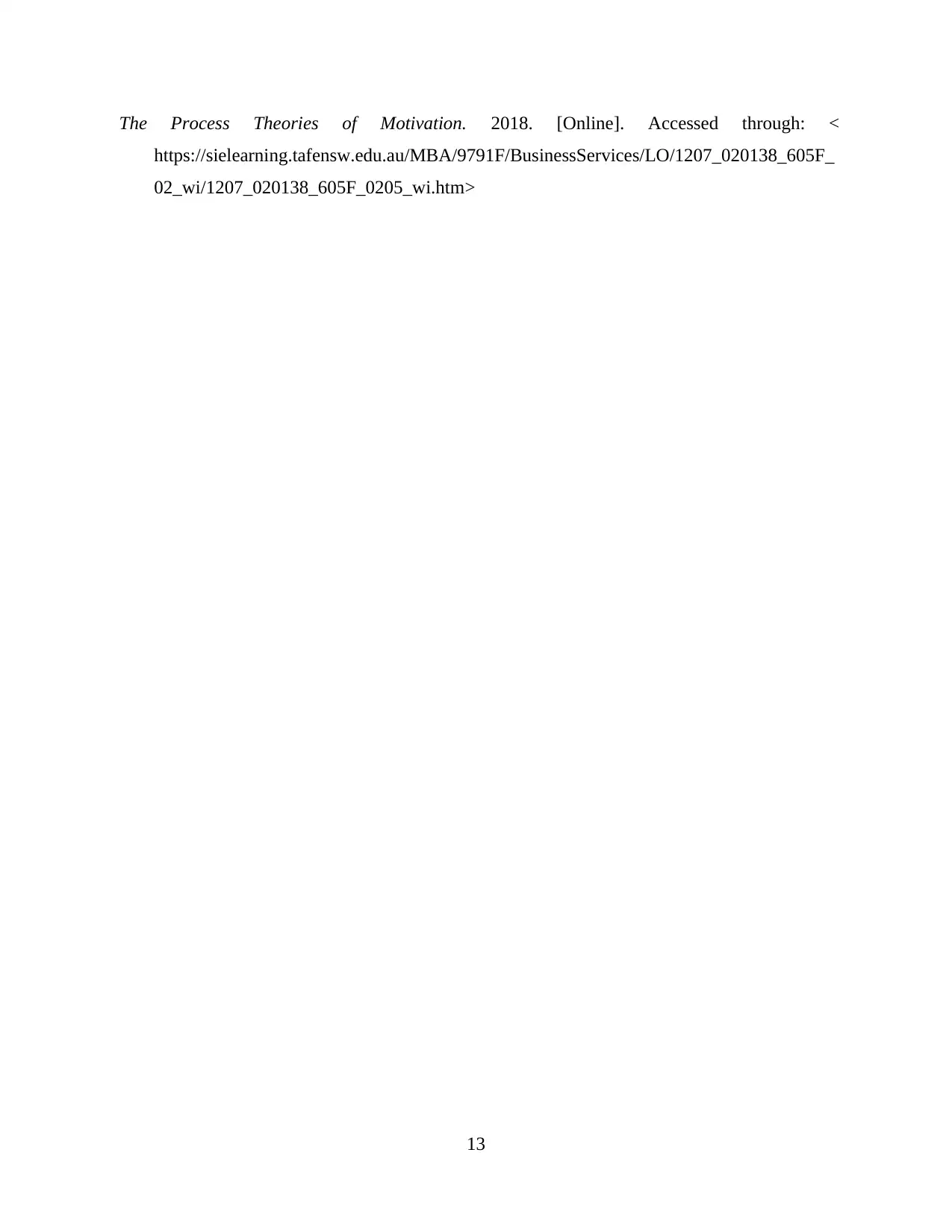
The Process Theories of Motivation. 2018. [Online]. Accessed through: <
https://sielearning.tafensw.edu.au/MBA/9791F/BusinessServices/LO/1207_020138_605F_
02_wi/1207_020138_605F_0205_wi.htm>
13
https://sielearning.tafensw.edu.au/MBA/9791F/BusinessServices/LO/1207_020138_605F_
02_wi/1207_020138_605F_0205_wi.htm>
13
1 out of 15
Related Documents
Your All-in-One AI-Powered Toolkit for Academic Success.
+13062052269
info@desklib.com
Available 24*7 on WhatsApp / Email
![[object Object]](/_next/static/media/star-bottom.7253800d.svg)
Unlock your academic potential
© 2024 | Zucol Services PVT LTD | All rights reserved.





